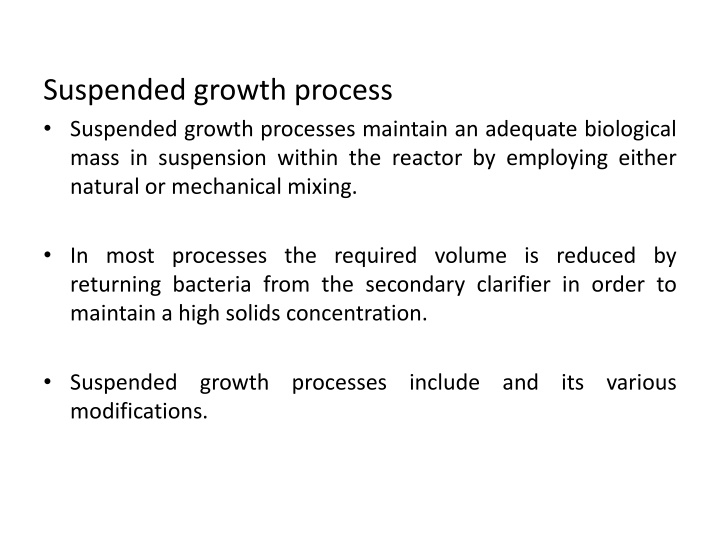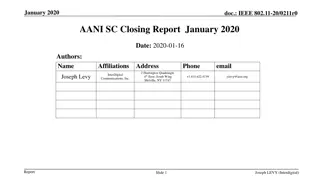
Suspended Growth Processes in Biological Systems
Suspended growth processes are vital in maintaining biological mass within reactors through natural or mechanical mixing. Learn about the principles, design factors, and operation of suspended growth systems, including the mean cell residence time and total microbial mass calculations. Explore the implications of completely mixed processes with solids recycle and factors like wastewater flow rate and sludge age. Dive into the significance of Food-to-Microorganism ratio in activated sludge processes and design scenarios for efficient wastewater treatment.
Download Presentation

Please find below an Image/Link to download the presentation.
The content on the website is provided AS IS for your information and personal use only. It may not be sold, licensed, or shared on other websites without obtaining consent from the author. If you encounter any issues during the download, it is possible that the publisher has removed the file from their server.
You are allowed to download the files provided on this website for personal or commercial use, subject to the condition that they are used lawfully. All files are the property of their respective owners.
The content on the website is provided AS IS for your information and personal use only. It may not be sold, licensed, or shared on other websites without obtaining consent from the author.
E N D
Presentation Transcript
Suspended growth process Suspended growth processes maintain an adequate biological mass in suspension within the reactor by employing either natural or mechanical mixing. In most processes the required volume is reduced by returning bacteria from the secondary clarifier in order to maintain a high solids concentration. Suspended modifications. growth processes include and its various
Principals of suspended growth system The basic factor in design, control and operation of suspended growth system is the mean cell residence time or sludge age ( c). ? ?? ?? ?c= X= the total microbial mass in a reactor. dx/dt = total quality of solids withdrawn. For an equilibrium system : Quantity of solids produced = quantity of solids lost
Completely mixed process with solids recycle: The completely mixed model presented below is applicable to activated sludge system.
Q: wastewater flow rate X : mixed liquor suspended solids concentration (MLSS). X r: the clarifier underflow suspended solids concentration. X e: the effluent suspended solids concentration. Q w: the waste sludge flow rate. Q r : the return sludge flow rate. The explicit assumption of the model are that all waste utilization occurs in the biological reactor and that the total biological mass in the system is equal to the biological mass in the reactor.
The mean cell residence time (sludge age) for this system is defined by: ? ?? ?? ? ? ?c= = ????+(? ??)?? If solids are wasted from the reactor directly, the above equation will become: ? ? ?c= ??? +(? ??)??
The total microbial mass in the reactor is given by: ?? ?0 ? ?c 1 + ???c ?? = ?? ? ? ?0 ? 1 + ???c ? = Where: Y= mass of cell produced / mass of substrate used. S0= influent BOD S= effluent soluble BOD ? = liquid retention time in the reactor , V/Q Kd= a microorganism decay coeff. (mass of cell/ mass of cell. time).
An important factor in design, operation and control of activate sludge process is Food/ Microorganism ratio. ? ?= ?0 ? ? ?? Ex/ Design an activated sludge process to yield an effluent BOD of 20 mg/L and suspended solids of 25 mg/L. The influent BOD following primary clarifier is 160 mg/L. Assume Y=0.65, Kd= 0.05 and c= 10 days. The waste flow is 10 m3/ min. Effluent soluble BOD = 4 mg/L.
Solution: Total biological mass is calculated from ?? ?0 ? ?c 1+???c ?? = 0.65 10 1000 60 24 160 4 (10) = 9.73x 109 ?? = 1+0.05 10 Assuming a mixed liquor volatile suspended solids concentration 2500 mg/L V = 9.73 X 109/ 2500 = 3.894 X 106L = 3894 m3
The rate of sludge (biological solids) production is obtained from following equation : ?? ??= ?? ?? 9.73 109 10 106= 973.5 ??/??? ?? ??= Assume the solids are 80% volatile, total production would be: 973.5/0.8 = 1217 kg/day (MLVSS = 0.8 MLSS) The underflow solids concentration is unlikely to exceed 15000 mg/L and could well be less. Assume Xr= 15 000 mg/L
?? ??= ????+ ? ?? ?? 1217 106?? ??? 103=81.1 m3/ day ??= 15 103?? ?
Recirculation flow can be calculated from mass balance around the reactor as shown: Q X0+ QrXr+ dx/dt = (Q+Qr)X ? ? ?? ? 10 2500 12 500 ?? = 2 m3/min ??= ?? = r = Qr/Q = 0.2 The hydraulic retention time in the reactor is: t = V/Q = 3894/14400 = 0.27 days = 6.5 hrs
Calculate O2requirement O2demand = 1.47 (S0 S) Q 1.14 XrQw = 1.47 (160 - 4) (14.4 X 106) 1.14 (15 000) (81100) = 1.915 X 109mg/day = 1915 kg/day The volume of air required in m3may be calculated from: ?2?????? 0.232?? ?2 = 6856 m3/day ???? = ?? ??? 1.2?? ??? ?3 ??? If the actual efficiency of the oxygen transfer is 7%, the air required will be Q air = 6856/0.07 = 97943 m3/day










